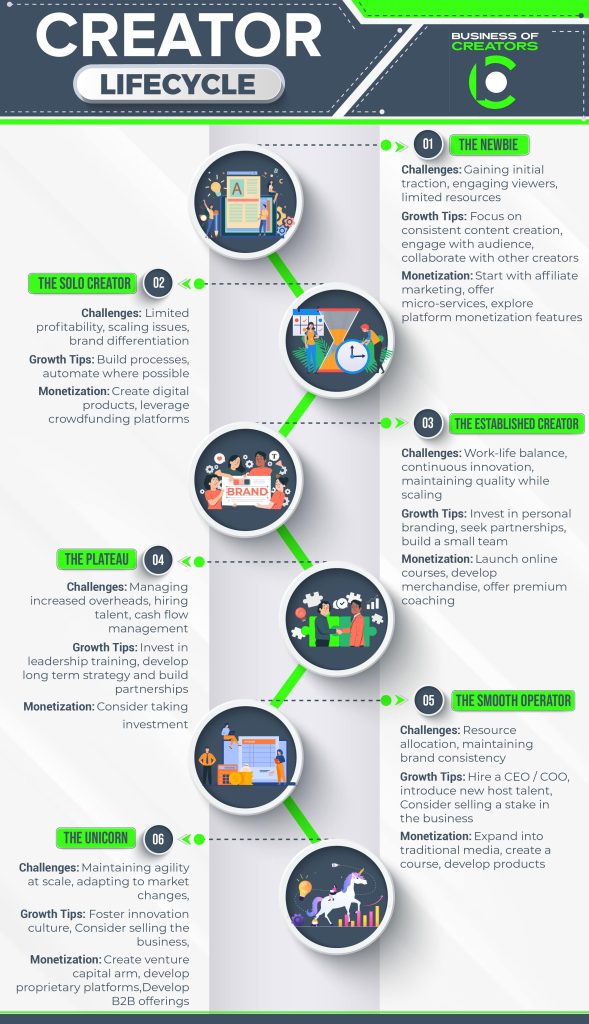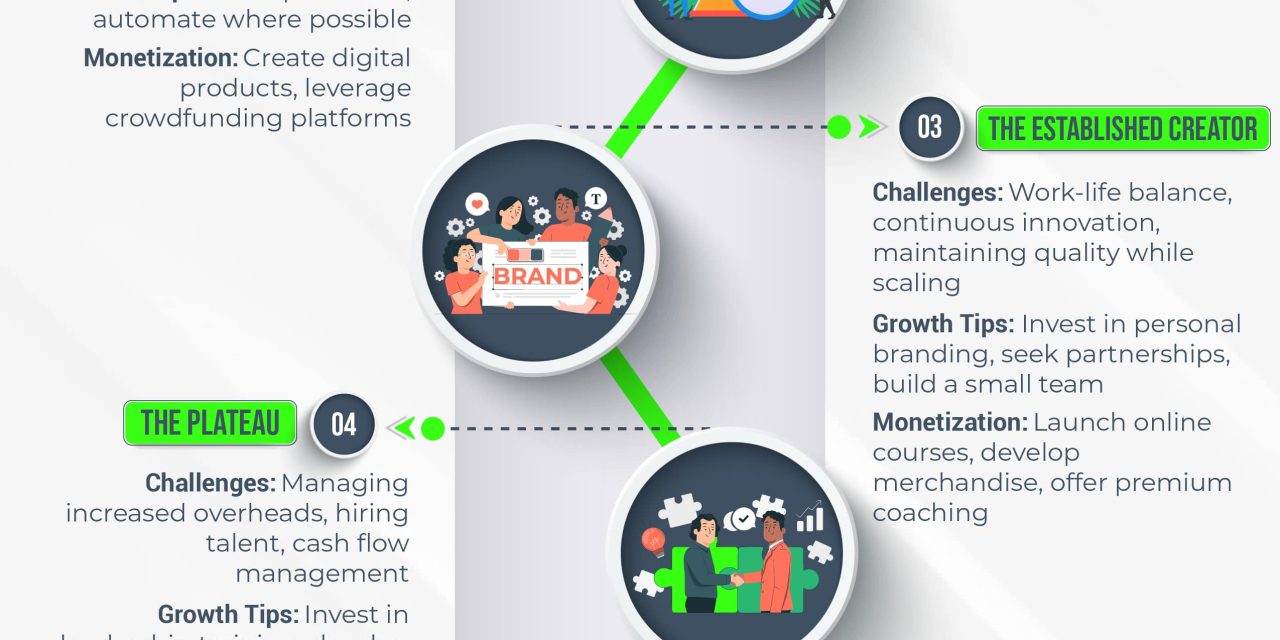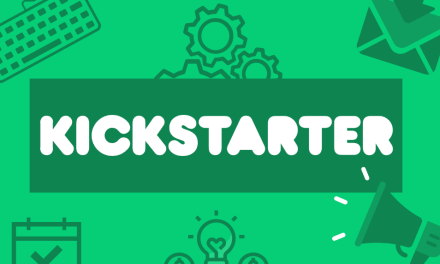Growing a content creator career is challenging, but understanding the common stages can help you navigate this journey more effectively. Over the last eight years I’ve spoken to more than 500 creators, including many of the world’s leading creators, and have identified the six key stages that content creators typically go through when growing their influence. Each stage presents its own unique set of opportunities and challenges.
I wanted to create an infographic to present this lifecycle and turned to Fiverr to help. Within 24 hours I’d found a freelancer who could turn my vision into reality! Check out the link in the comments where I break down these six stages and the opportunities within each one. And grab 10% off Fiverr with code IAN10.

Stage 1: THE NEWBIE
Every content creator begins as a newbie. This stage is exciting, full of possibilities, but success is uncertain.
Challenges include:
- Struggle to gain traction: Building an initial audience is often the biggest hurdle for newbies. Your content may be high-quality, but without an existing following, it can feel like you’re shouting into the void. However whilst algorithms previously favoured established creators with subscribers, today the algorithms reward content that keeps the audience engaged.
- Difficulty engaging viewers: Even when you start to attract viewers, keeping them engaged can be challenging. You’re still learning how to create compelling content, nail your delivery, and develop a unique voice that stands out in a crowded digital landscape. Turning casual viewers into loyal followers requires skills that come with repetition
- Scarce resources: As a newcomer, you’ll likely face limitations in equipment, budget, and skills. This can manifest as using basic recording equipment, struggling to afford necessary software subscriptions, or lacking the technical expertise to produce high-quality content consistently. You might find yourself wearing multiple hats – creator, editor, marketer, and strategist – which can be overwhelming and time-consuming.
- Uncertain audience validation: At this stage, you’re still trying to find your niche and target audience. There’s a constant worry about whether your content resonates with viewers and if there’s a genuine demand for what you’re creating. This uncertainty can lead to frequent pivots in content strategy or self-doubt about your chosen direction.
Tips for growth:
- Focus on consistently creating high-quality content: Establish a regular posting schedule and maintain it. Prioritize quality over quantity, and continually refine your content based on audience feedback and performance metrics.
- Engage with your audience and build a community: Respond to comments, create polls, and ask for feedback. Use social media platforms to interact with your audience outside of your main content channel. Foster a sense of belonging among your early followers.
- Collaborate with other newbie creators in your niche: Reach out to creators at a similar level for collaborations, guest appearances, or cross-promotions. This can help you tap into each other’s audiences and learn from one another’s experiences.
- Experiment with different content formats and topics: Don’t be afraid to try various content types (e.g., short-form, long-form, live streams, podcasts) and explore different topics within your niche to find what resonates best with your audience and what you enjoy creating most.
Monetization strategies:
- Start with affiliate marketing: Begin by promoting products or services you genuinely use and love. Create honest reviews, comparisons, or how-to content that naturally incorporates affiliate links. Focus on building trust with your audience while introducing them to valuable products.
- Offer micro-services related to your content: Leverage your skills to offer small, affordable services to your audience or other creators. This could include things like social media audits, basic graphic design, or short consultations in your area of expertise.
- Explore platform-specific monetization features: Familiarize yourself with and utilize monetization features offered by the platforms you use, such as YouTube’s Partner Program, Instagram’s branded content tools, or TikTok’s Creator Fund. While the income may be small at first, it can provide valuable insights into what content performs best.
Recommended Listening
EPISODE: How to succeed in the Creator Economy with industry veteran Avi Gandhi
This podcast provides valuable insights for those just starting out in the creator economy.
EPISODE: Behind the scenes at YouTube with Rene Ritchie
Helps new creators optimize their content on one of the most popular platforms.
EPISODE: Launching and growing a podcast with Alban Brooke from Buzzsprout
Perfect for newbies looking to start their content creation journey with podcasting.
Stage 2: THE SOLO CREATOR
At this stage, creators have formed a small but loyal audience, yet profitability often remains elusive.
Challenges include:
- Limited profitability: While you’ve managed to build a small, loyal audience, translating that into sustainable income is often a struggle. You may find yourself investing more time and resources into content creation than you’re able to recoup financially. This can lead to burnout and questioning the viability of your creator career, especially if you’re trying to transition from a traditional job.
- Scaling issues: As a solo creator, you’re likely handling all aspects of your content business yourself. This can create bottlenecks in your workflow and limit your ability to increase output or improve quality. You might find yourself working longer hours but still struggling to meet the growing demands of your audience and the platforms you’re on.
- Brand differentiation: In a crowded creator economy, standing out becomes increasingly challenging. You might struggle to articulate what makes your content unique or valuable compared to other creators in your niche. This can make it difficult to attract new followers or secure brand partnerships, as potential collaborators may not see a clear value proposition.
Tips for growth:
- Expand your content to related niches: Gradually broaden your content topics to attract a wider audience while maintaining your core focus. This can help you appeal to new viewers without alienating your existing fan base.
- Build valuable assets: Create long-lasting assets that provide value to your audience and generate passive income. This could include developing an email list, building a website or blog, creating an online course, or writing an ebook related to your niche.
- Automate and outsource where possible: Identify time-consuming tasks that can be automated or outsourced. This might include using scheduling tools for social media posts, hiring a virtual assistant for administrative tasks, or outsourcing video editing to free up more time for content creation.
- Focus on creating a unique brand identity: Develop a distinctive voice, visual style, and content approach that sets you apart from others in your niche. Consistency in your branding across all platforms will help build recognition and loyalty among your audience.
Additional monetization strategies:
- Create and sell digital products: Develop low-cost, high-value digital products such as ebooks, templates, presets, or mini-courses related to your niche. These can provide passive income and help establish you as an authority in your field.
- Implement tiered pricing for services: If you offer services, create different pricing tiers to cater to various customer needs and budgets. This could include basic, standard, and premium packages for consulting, coaching, or custom content creation.
- Leverage crowdfunding platforms: Consider using platforms like Patreon, Ko-fi, or Buy Me a Coffee to allow your most dedicated fans to support your work directly. Offer exclusive perks or behind-the-scenes content to incentivize ongoing support.
- Explore sponsored content opportunities: As your audience grows, start reaching out to brands for sponsored content deals. Focus on maintaining authenticity by only partnering with brands that align with your values and audience interests.
Recommended Listening
EPISODE: Monetizing your audience with Simon Ellington from Ko-fi
Introduces solo creators to a popular platform for direct audience support.
EPISODE: How to make $1m in passive revenue via syndication with Alex Chavez-Munoz from Wild Vision
Offers insights into scaling income as a solo creator.
EPISODE: Exploring some of the most powerful editing tools with Zeev Farbman from Lightricks
Helps solo creators enhance their content quality with powerful tools.
Stage 3: THE ESTABLISHED CREATOR
Established creators have a dedicated audience, minimal overheads, and a spirited culture. They enjoy better income, enhanced freedom, and more significant impact than a traditional job.
Challenges include:
- Maintaining work-life balance: As your brand grows, you may find it increasingly difficult to separate your personal life from your creator persona. The pressure to constantly create content, engage with your audience, and stay relevant can lead to burnout. You might struggle with setting boundaries and taking time off without feeling guilty or fearing audience attrition.
- Continuous innovation: With an established audience comes the pressure to consistently deliver fresh, engaging content. You may find it challenging to balance meeting audience expectations with experimenting with new content formats or topics. There’s a constant need to stay ahead of trends and algorithm changes while maintaining your authentic voice and brand identity.
- Scaling without compromising quality: As demand for your content grows, you face the challenge of increasing your output without sacrificing the quality that built your audience. This often requires delegating tasks or building a team, which comes with its own set of challenges in terms of management, training, and maintaining a consistent brand voice across multiple contributors.
- Diversifying revenue streams: While you may have a primary income source, relying too heavily on one platform or revenue stream can be risky. You face the challenge of expanding your income sources (e.g., merchandise, courses, speaking engagements) without overextending yourself or diluting your brand. Each new venture requires time and resources to develop and market effectively.
Tips for growth:
- Invest in personal branding and professional development: Refine your personal brand to align with your long-term goals. Attend industry conferences, network with other creators, and consider working with a coach or mentor to further develop your skills and strategy.
- Seek strategic partnerships and collaborations: Pursue partnerships with brands that align with your values and audience interests. Look for opportunities to collaborate with larger creators or complementary brands to expand your reach and credibility.
- Explore new platforms and content formats: Stay ahead of trends by experimenting with emerging platforms and content formats. This could involve creating content for new social media platforms, starting a podcast, or exploring interactive content formats to engage your audience in novel ways.
- Build a small team or network of freelancers: Start delegating tasks by hiring part-time assistants or freelancers for specific roles like video editing, graphic design, or social media management. This allows you to focus on high-impact activities while maintaining quality across all aspects of your content creation.
- Create systems and processes to maintain consistency: Develop standard operating procedures for content creation, audience engagement, and business operations. This will help you maintain quality and consistency as you scale, and make it easier to onboard team members in the future.
Additional monetization strategies:
- Launch a flagship online course or membership program: Create a comprehensive course or ongoing membership program that provides significant value to your audience. This can become a major revenue stream and help position you as a leading expert in your niche.
- Develop physical products or merchandise: Consider creating branded merchandise or physical products related to your content. This could range from apparel and accessories to niche-specific tools or equipment.
- Offer high-ticket coaching or consulting packages: Leverage your growing reputation to offer premium, one-on-one or small group coaching sessions. These can be priced significantly higher than your other offerings, providing a substantial income boost.
- Explore licensing and intellectual property opportunities: Look into licensing your content, brand, or proprietary methods to other businesses. This could include content syndication, brand licensing for products, or creating certification programs.
Recommended Listening
Explores additional monetization strategies for established creators.
EPISODE: Editing videos using AI with Opus Clip
Introduces established creators to AI tools that can enhance their workflow.
Stage 4: THE PLATEAU
Creators in this stage are stuck between being a small influencer and becoming a brand. They face increasing overheads and the need for a more robust team.
Challenges include:
- Balancing increased overheads with revenue: As your operation grows, so do your expenses. You’re likely investing in better equipment, software, and possibly office space. You may also be starting to hire staff or contractors. Balancing these increased costs with your revenue can be tricky, especially if your growth in audience or income starts to plateau.
- Sustaining brand image during transitions: As you transition from a solo creator to a larger operation, maintaining a consistent brand image becomes more complex. You may struggle with delegating creative control or ensuring that your expanded team can authentically represent your brand voice across all platforms and interactions.
- Managing cash flow: With more complex operations come more complex financial management needs. You may face challenges in forecasting income, managing irregular payment schedules from various platforms or sponsors, and ensuring you have enough cash on hand to cover growing operational costs and invest in future growth.
- Adapting growth strategies: The strategies that got you to this point may no longer be sufficient for continued growth. You face the challenge of developing and implementing new approaches to content creation, audience engagement, and monetization. This often requires a shift in mindset from being purely a content creator to being a content entrepreneur.
Tips for growth:
- Invest in leadership and management training: As your team grows, develop your skills in leadership, team management, and effective communication. Consider taking courses or working with a business coach to help you transition from a solo creator to a leader of a content creation team.
- Develop a clear long-term vision and strategy: Create a detailed business plan that outlines your goals, target audience, content strategy, and revenue projections for the next 3-5 years. This will help guide your decision-making and resource allocation as you grow.
- Focus on scaling your most profitable content and products: Analyze your content and product offerings to identify what generates the most revenue and audience engagement. Allocate more resources to these areas while phasing out or redesigning less successful offerings.
- Build strategic partnerships to share resources and reach: Collaborate with other creators or businesses in complementary niches to share production costs, cross-promote content, or develop joint products. This can help you reach new audiences and create more ambitious projects without significantly increasing your overhead.
- Consider seeking outside investment or funding: If you have a solid business plan and growth potential, explore options for external funding. This could include angel investors, venture capital, or even crowdfunding campaigns to help you overcome financial barriers to growth.
Additional monetization strategies:
- Create a mix of high-end and accessible offerings: Develop a product suite that includes both premium, high-priced offerings (like VIP retreats or done-for-you services) and more accessible options (like group programs or lower-priced digital products) to maximize revenue across different audience segments.
- Implement dynamic pricing and limited-time offers: Use scarcity and urgency tactics ethically to boost sales. This could include seasonal promotions, early-bird pricing for new offerings, or exclusive deals for your email list subscribers.
- Explore white-labeling opportunities: Consider creating white-label versions of your successful products or services that other businesses or creators can sell under their own brand, providing you with a new revenue stream.
- Develop corporate training or B2B offerings: Adapt your expertise and content for corporate clients. This could involve creating custom training programs, workshops, or consulting packages tailored to businesses in your niche.
Recommended listening
EPISODE: A New AI Chatbot To Help Creators Scale with Sean Kim, President of Kajabi
Offers solutions for creators looking to overcome growth plateaus.
EPISODE: From Rapper to Creator Economy Pioneer with Iggy Azalea
Provides inspiration and strategies for diversifying one’s creator career.
Stage 5: THE SMOOTH OPERATOR
This stage sees a significant increase in team size, creating a challenging and stressful environment.
Challenges include:
- Retaining top talent: As your team grows, keeping your best performers becomes increasingly difficult. High-performers may leave due to burnout, lack of career progression opportunities, or better offers from competitors. This turnover can result in a loss of institutional knowledge and disruption to your content creation process.
- Limited funds for innovation: With increased operational costs, you may find it challenging to allocate sufficient resources for experimenting with new content ideas or emerging platforms. This can lead to stagnation in your content offering, making it harder to stay relevant and attract new audience members.
- Inefficient resource allocation: As your operation becomes more complex, ensuring that your resources (both financial and human) are being used optimally becomes more challenging. You may struggle with identifying which aspects of your business are most profitable and deserve more investment versus which areas might need to be scaled back.
- Eroding brand image: Rapid expansion and high staff turnover can lead to inconsistencies in your content quality or brand voice. You may find it challenging to maintain the personal touch that initially attracted your audience as your operation becomes more corporate in structure.
- Scaling challenges: The pressure to continually grow can lead to taking shortcuts in content creation or audience engagement. This can result in a decline in content quality or authenticity, potentially damaging your brand’s reputation and audience loyalty in the long run.
Tips for growth:
- Implement robust HR practices and career development programs: Develop comprehensive onboarding processes, offer regular performance reviews, and create clear career progression paths for team members. Invest in ongoing training and development to retain top talent and maintain a high-performing team.
- Allocate resources for innovation and experimentation: Set aside a portion of your budget and team capacity for exploring new content ideas, technologies, or business models. Create a culture that encourages calculated risk-taking and learning from both successes and failures.
- Develop efficient systems and processes: Implement project management tools and workflows to streamline content production, distribution, and audience engagement. Regularly review and optimize these processes to increase efficiency and maintain quality as you scale.
- Maintain brand consistency across all channels: Develop comprehensive brand guidelines and ensure all team members are trained in maintaining brand consistency. Regularly audit your content and communications across all platforms to ensure a cohesive brand experience for your audience.
- Focus on sustainable, quality-driven growth: Prioritize long-term sustainability over rapid expansion. Carefully consider the impact of new initiatives on your team, resources, and brand quality. Aim for steady, manageable growth that allows you to maintain the quality and authenticity that your audience values.
Tips for growth:
- Explore traditional media expansion: Consider expanding into traditional media formats like television shows, movies, or print publications. Your established brand and audience can make these ventures more likely to succeed.
- Develop a course: If you’ve created a successful business model or teaching methodology, consider designing a course to sell.
- Launch a SaaS (Software as a Service) product: Identify common pain points in your industry and develop a software solution. This could become a significant recurring revenue stream while adding value to your niche.
- Explore media deals and productions: Look into opportunities for larger media productions, such as creating a documentary series, writing a book with a major publisher, or developing a podcast network.
Recommended Listening
Offers insights into managing a successful creator team.
EPISODE: Translating YouTube for a global audience with Farbod Mansorian from Unilingo
Explores strategies for expanding to international audiences.
Stage 6: THE UNICORN
At this stage, creators have built large, established media empires with numerous assets and a vast workforce.
Challenges include:
- Maintaining agility and innovation in a bureaucratic structure: As your content empire grows, decision-making processes often become more complex and time-consuming. This can make it difficult to respond quickly to trends or implement innovative ideas, potentially causing you to lose your edge in a fast-moving digital landscape.
- Adapting to shifting market demands and audience preferences: With a large, diverse audience, pivoting your content strategy or brand image becomes more complex and risky. You may struggle to stay relevant to younger audiences while not alienating your existing fan base.
- Balancing short-term profitability with long-term growth and sustainability: There’s constant pressure to meet quarterly financial targets while also investing in long-term initiatives that may not show immediate returns. This balancing act can lead to difficult decisions about resource allocation and strategic direction.
- Navigating an increasingly complex regulatory environment: As a major player in the media landscape, you face increased scrutiny from regulators on issues like data privacy, content moderation, and fair competition. Staying compliant across different jurisdictions while maintaining your operational efficiency becomes a significant challenge.
- Managing and mitigating reputational risks in a hyper-connected world: With your increased visibility comes increased vulnerability to PR crises. A single misstep can quickly escalate into a major controversy, requiring sophisticated crisis management strategies and proactive reputation management.
Tips for growth:
- Foster a culture of innovation and intrapreneurship: Encourage creativity and initiative among your team members. Create platforms for employees to pitch new ideas and provide resources to develop promising concepts into full-fledged projects or spin-off brands.
- Invest in cutting-edge technology and digital transformation: Stay at the forefront of technological advancements in content creation, distribution, and audience engagement. This might include exploring AI-powered content personalization, virtual reality experiences, or blockchain-based audience rewards systems.
- Diversify content offerings and revenue streams: Continually expand your content portfolio and explore new monetization strategies. This could involve launching niche-specific sub-brands, developing proprietary technology platforms, or even acquiring smaller content creators or complementary businesses.
- Develop a strong corporate social responsibility program: Use your influence and resources to make a positive impact. This could involve supporting causes aligned with your brand values, implementing sustainable business practices, or using your platform to raise awareness about important social issues.
- Stay connected with your audience despite your size: Maintain authenticity and personal connection with your audience through regular direct engagement. This might include hosting exclusive events, creating behind-the-scenes content, or implementing a robust community management strategy across all your platforms.
- Mentor and incubate emerging creators: Develop programs to support and nurture up-and-coming talent in your industry. This not only gives back to the creator community but also helps you stay connected to emerging trends and potentially discover new talent for your organization.
Additional monetization strategies:
- Create a venture capital arm: Establish a VC fund to invest in promising startups in the creator economy or your specific niche. This can provide substantial returns and keep you at the forefront of industry innovations.
- Develop proprietary technology or platforms: Invest in creating unique technological solutions for content creators or your audience. This could become a major business in itself, separate from your content creation activities.
- Create a digital or physical event: Develop a series of large-scale conferences, festivals, or retreats. These events can become significant profit centers while also strengthening your community and brand positioning.
- Establish an education institution: Consider founding a school, college, or training institute focused on your area of expertise. This could range from online-only programs to full-fledged physical campuses.
Recommended Listening
EPISODE: Investing in Creators with Megan Lightcap from Slow Ventures and the Creator Fund
Explores investment opportunities for successful creators.
EPISODE: The future of the Creator Economy with Sasha Kaletsky from Creator Ventures
Offers insights into future trends for top-tier creators.
EPISODE: The launch of LIONS Creators with Cannes Lions CEO Simon Cook
Introduces high-level networking and recognition opportunities for top creators.
By understanding these stages and implementing the growth strategies at each level, content creators can navigate their journey more effectively, overcoming challenges and maximizing their potential for success in the creator economy.






